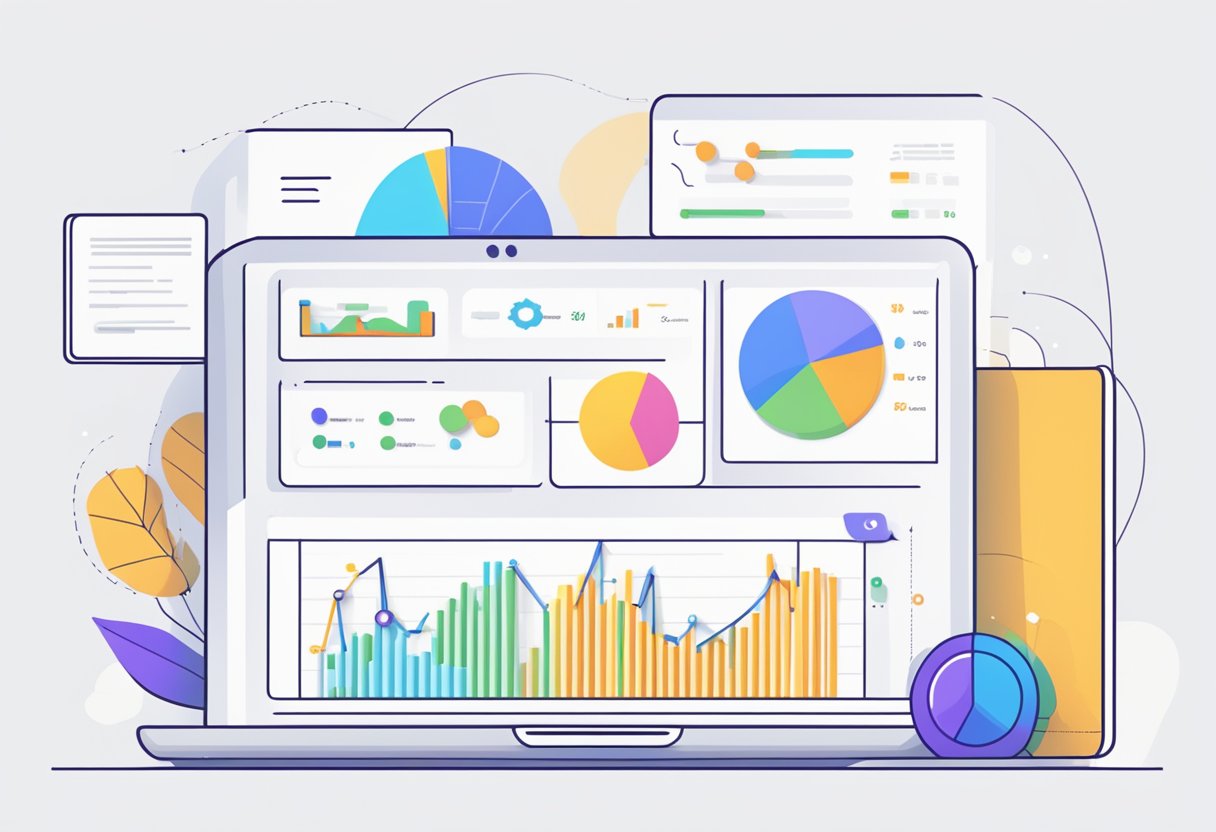Core Web Vitals are a set of metrics devised by Google to help you understand and enhance your website's user experience in terms of loading, interactivity, and visual stability.
These vitals aim to quantify the feel of a user's experience on a webpage, shedding light on areas that could affect someone's ability to quickly and easily access content.

When considering the speed of your website, you'll focus on the Largest Contentful Paint (LCP) metric, which measures how long it takes for the majority of content on a page to load.
A fast LCP contributes to the perception that your site is quick, directly affecting user satisfaction. The First Input Delay (FID) metric gauges interactivity by recording the time from when a user first interacts with your page to the moment when the browser can respond to that interaction. Quick responses are essential for a smooth user experience.
The visual stability of a page is measured by the Cumulative Layout Shift (CLS) metric, which assesses how often users experience unexpected layout shifts.
A low CLS ensures that the page is stable as it loads, preventing frustrating experiences where elements on the page move around as additional content loads. By aiming to improve these Core Web Vitals, you're essentially refining the performance of your website, a key factor in its success and visibility online.
Understanding Core Web Vitals

Core Web Vitals are crucial metrics that reflect the quality of user experience on your website, focusing on loading times, interactivity, and visual stability.
Significance of Core Web Vitals
Your website’s ranking in search results can be significantly influenced by its Core Web Vitals, as they are direct indicators of user experience. A site that performs well on these metrics is more likely to retain users, decrease bounce rates, and ultimately achieve better conversion rates. Google uses these vitals as part of its ranking algorithm, emphasising the value of optimising them for search engine optimisation (SEO).
Components Defined
Largest Contentful Paint (LCP): This measures how long it takes for the largest content element on your page (like an image or block of text) to load. Ideal LCP should occur within 2.5 seconds of when the page first starts loading.
- Good: 2.5 seconds or faster
- Needs Improvement: Between 2.5 seconds and 4 seconds
- Poor: Over 4 seconds
First Input Delay (FID): This vital gauges the time from when a user first interacts with your page (like clicking a link or tapping on a button) to the time when the browser is able to respond to that interaction. This metric is crucial for understanding the interactivity of your page. An ideal FID is less than 100 milliseconds.
- Good: Less than 100 milliseconds
- Needs Improvement: 100–300 milliseconds
- Poor: Over 300 milliseconds
Cumulative Layout Shift (CLS): CLS measures the stability of your website by calculating how much visible content shifts around during the loading process. It helps you understand the visual stability of your page. For a good user experience, strive for a CLS score of less than 0.1.
- Good: Less than 0.1
- Needs Improvement: 0.1–0.25
- Poor: Over 0.25
Evaluating Web Vitals Metrics

When assessing the performance of your website, it is crucial to understand the specific metrics that Google uses to measure user experience. The Core Web Vitals metrics are integral in evaluating a site's health, focusing on aspects like load times, interactivity, and visual stability.
Largest Contentful Paint (LCP)
LCP measures the time taken for the largest content element on your page to fully load. This metric is a key indicator of loading performance. To ensure a satisfactory user experience, you should aim to have an LCP of 2.5 seconds or faster.
- Good: Less than 2.5 seconds
- Needs improvement: Between 2.5 and 4 seconds
- Poor: More than 4 seconds
First Input Delay (FID)
FID quantifies the time from when a user first interacts with your page (i.e., when they click a link, tap on a button) to the time when the browser is actually able to respond to that interaction. This metric captures the interactivity of the site. For top performance, strive for an FID of 100 milliseconds or less.
- Good: Less than 100 milliseconds
- Needs improvement: Between 100 milliseconds and 300 milliseconds
- Poor: More than 300 milliseconds
Cumulative Layout Shift (CLS)
CLS is all about visual stability and measures how much elements within the viewport move around during your page's load time. Unexpected movement can be frustrating for users, so you should aim for a CLS score of 0.1 or less.
- Good: Less than 0.1
- Needs improvement: Between 0.1 and 0.25
- Poor: More than 0.25
By focusing on these metrics, you can improve not just the individual scores but the overall feel and usability of your website.
Tools and Reporting for Web Vitals

Understanding how your website performs in terms of user experience is pivotal for achieving a successful online presence. Google offers a comprehensive set of tools specifically designed to assist in measuring and improving your web vitals.
Google's Suite of Tools
PageSpeed Insights: This tool allows you to analyse the content of a web page and then provides suggestions to make that page faster. It incorporates data from the Chrome User Experience Report to provide real-world performance insights.
Search Console: Inside Google Search Console, the Web Vitals Report gives an overview of your pages' performance based on real-world usage data. It helps identify areas where your site could be improved.
Lighthouse: An open-source, automated tool for improving the quality of web pages. You can run it against any web page, public or requiring authentication. It provides audits for performance, accessibility, progressive web apps, SEO and more.
Chrome User Experience Report: A public dataset of user experience metrics for how real-world Chrome users experience popular destinations on the web. It’s a powerful resource for understanding true user experiences on your website.
Web Vitals Report Overview
The Web Vitals Report in Google Search Console presents a detailed analysis of the performance of your pages. It offers actionable insights by categorising your pages into "Good", "Needs Improvement", or "Poor" based on their adherence to benchmarked web vital metrics.
- Good: Pages meet or exceed the recommended thresholds for the core web vitals metrics.
- Needs Improvement: Pages don't consistently meet the recommended thresholds.
- Poor: Pages are far from meeting the recommended thresholds and require significant improvements.
By regularly monitoring this report, you can track improvements over time or identify new issues as they arise. Integrating these tools into your workflow is crucial in optimising your website's user experience.
Optimising for Better Web Vitals

To provide a superior user experience, keen attention to Core Web Vitals is crucial. This segment focuses on technical refinements and ideal practices to enhance web performance, in addition to diagnosing and rectifying common issues that might impair page experience.
Technical Enhancements and Best Practices
Your first objective in optimising Core Web Vitals should be to improve loading performance. Start by scrutinising your Largest Contentful Paint (LCP), which measures the load time of the main content on your page. Aim for an LCP of 2.5 seconds or faster. This may involve:
- Optimising images: Compress and format images efficiently. Utilise modern formats like WebP when suitable.
- Browser caching: Leverage browser caching to speed up page load times for repeat visitors.
- Minify CSS, JavaScript, and HTML where possible to decrease file sizes.
Another critical measure is the First Input Delay (FID), which tracks interactivity. To optimise FID:
- Resolve JavaScript execution issues to reduce Total Blocking Time (TBT), a proxy for FID.
- Remove any non-critical third-party scripts that may bog down your site.
Finally, address Cumulative Layout Shift (CLS) by:
- Ensuring images and embeds have dimensions specified to prevent layout shifts.
- Avoiding the insertion of content above existing content unless in response to a user's action.
Common Issues and Solutions
Encountering issues like slow server response times can detract from your site's UX. To mitigate such problems:
- Evaluate your hosting solution. Can it handle your site's traffic efficiently?
- Implement a Content Delivery Network (CDN) to reduce latency.
For SEO and page experience enhancements, pinpoint any layout shifts that cause visual instability:
- Stabilise the positioning of ads and embeds to avoid sudden shifts.
- Exercise meticulous design practices to ensure elements maintain their layout during loading.
By adhering to these guidelines and performing regular audits of your website's performance, you can sustain a good user experience that aligns with your SEO goals.
Impact of Core Web Vitals on SEO

Core Web Vitals have become a significant aspect of SEO by directly influencing your page's visibility in search results and the experience users have on your site.
Ranking Factors and User Experience
Google has incorporated Core Web Vitals into its ranking factors, positively affirming the link between user experience and SEO. Your site's loading performance, interactivity, and visual stability are areas to optimise. Specifically:
- Site speed: A fast-loading page can improve your position in search results.
- Interactivity: Measured by First Input Delay, a low response time to user interaction can enhance your search ranking.
- Visual Stability: Ensuring elements don't shift during page load, measured by Cumulative Layout Shift, aids in maintaining user engagement.
Adressing these factors can lead to an uptick in your conversion rates, as they foster a more satisfying user experience.
The Future of Web Vitals and SEO Strategy
Moving forward, Google is likely to continue evolving its algorithms to prioritise page experiences. This places a focus on:
- Ongoing monitoring: Regularly check your Core Web Vitals using tools such as Google Search Console and PageSpeed Insights.
- Adapting strategies: Align your SEO efforts to accommodate future updates in web vitals, ensuring your site remains favourably positioned within search results.
By staying informed and responsive to these metrics, you secure a competitive edge in search engine optimisation, ultimately impacting your rankings and online success.
















